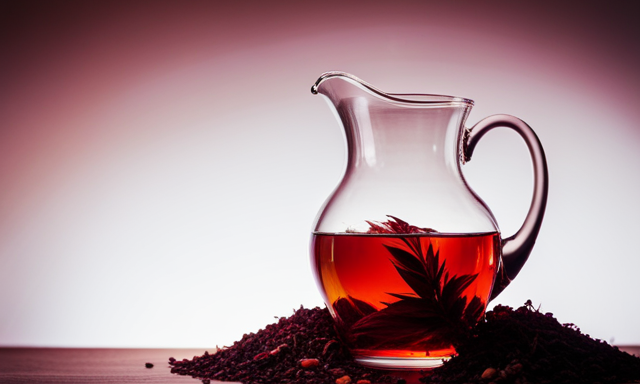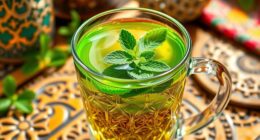As a lover of tea, I often find myself exploring the rich diversity of flavors and aromas that nature has to offer. One such tea that has captured my attention is rooibos tea. Derived from the leaves of the Aspalathus linearis plant, rooibos tea is a unique and flavorful beverage that has gained popularity around the world.
In this article, we will delve into the fascinating world of rooibos tea, exploring its history, cultivation, processing methods, and culinary uses.
But first, let’s take a moment to appreciate the parallelism between the name ‘rooibos’ and the vibrant red color of the tea. Just as the sun sets and paints the sky with hues of red, rooibos tea brings warmth and comfort to our cups.
So, join me on this journey as we uncover the secrets of this extraordinary plant and discover why rooibos tea has become a beloved companion for tea enthusiasts everywhere.
Key Takeaways
- Rooibos tea comes from the plant Aspalathus linearis.
- Indigenous Khoisan people in South Africa were the first to use rooibos tea for its medicinal properties.
- Rooibos tea requires well-drained sandy soil and a warm, dry climate to thrive.
- Harvesting the plant at around 30cm height and undergoing fermentation and drying processes enhance its flavor, color, and shelf life.
The History of Rooibos Tea
Imagine sipping on a warm cup of rooibos tea, as you delve into the fascinating history of this beloved herbal infusion.
Rooibos tea, also known as red bush tea, has a rich history of cultivation in South Africa. The indigenous Khoisan people were the first to discover the benefits of this plant and began using it for its medicinal properties.
Over time, rooibos tea gained cultural significance and became a popular beverage among the local population. However, it wasn’t until the 20th century that rooibos tea gained international recognition and popularity.
Today, it is enjoyed by people all around the world for its unique taste and numerous health benefits.
Now, let’s explore the rooibos plant, Aspalathus linearis, and learn more about its characteristics and cultivation methods.
The Rooibos Plant: Aspalathus Linearis
The Rooibos Plant, also known as Aspalathus Linearis, is where this delightful beverage is derived from – as the saying goes, ‘Variety is the spice of life!’
Rooibos tea is cultivated from the leaves and stems of this unique plant, which is native to the Cederberg region of South Africa. The cultivation process involves carefully tending to the plants, ensuring they receive adequate sunlight, water, and nutrients. Once the plants have reached maturity, the leaves and stems are harvested and then undergo a fermentation process to enhance the flavor and medicinal properties.
Rooibos tea is known for its numerous health benefits, including its high antioxidant content and anti-inflammatory properties. It is also caffeine-free, making it a popular choice for those looking for a soothing and relaxing beverage.
Moving on to the subsequent section about growing conditions and harvesting methods, the Rooibos Plant requires specific conditions to thrive and produce the best quality leaves and stems.
Growing Conditions and Harvesting Methods
To get the best quality leaves and stems for your delicious cup of Rooibos tea, you’ll want to make sure you provide the Rooibos Plant with the specific growing conditions and harvesting methods it needs to thrive.
The Rooibos Plant, scientifically known as Aspalathus Linearis, requires a unique set of growing techniques to ensure optimal growth. It thrives in well-drained sandy soil with a pH level between 6 and 7. The plant also prefers a warm and dry climate, with temperatures ranging from 20 to 30 degrees Celsius.
As for the harvesting process, it is crucial to wait until the plant reaches a height of around 30 centimeters before harvesting. This ensures that the leaves and stems have developed enough flavor and aroma.
Once harvested, the leaves and stems undergo a meticulous processing method involving fermentation and drying. This step is essential in enhancing the flavor and color of the Rooibos tea.
Processing Rooibos Leaves: Fermentation and Drying
For a delicious cup of Rooibos tea, you’ll want to know how the leaves are processed – just like how a skilled chef adds the perfect spices to a dish, the fermentation and drying of Rooibos leaves enhance their flavor and color.
To achieve the desired taste and aroma, Rooibos leaves undergo a carefully controlled fermentation process. The leaves are moistened and left to oxidize for a specific period of time, typically between 8 and 24 hours. This step is crucial as it allows for the development of Rooibos tea’s characteristic sweet, fruity, and slightly nutty flavors.
After fermentation, the leaves are spread out to dry in the sun. This drying process can take several days and is essential for preserving the tea’s vibrant red color and ensuring its long shelf life. The leaves are regularly turned to ensure even drying and prevent mold formation.
The fermentation and drying techniques used in processing Rooibos leaves result in a tea with a unique flavor profile that sets it apart from other herbal teas. As we explore further, we’ll delve into the distinct taste and health benefits of Rooibos tea.
The Unique Flavor Profile of Rooibos Tea
Get ready to experience a flavor like no other – Rooibos tea will tantalize your taste buds with its unique and delightful combination of sweet, fruity, and slightly nutty notes. The flavor profile of Rooibos tea is a result of its natural fermentation process.
During fermentation, the natural sugars in the leaves are released, giving the tea its sweet taste. The fruity notes come from the antioxidants present in the leaves, which provide a refreshing and vibrant flavor. The slight nuttiness adds depth and complexity to the overall taste.
To fully appreciate the flavor notes of Rooibos tea, it’s important to brew it properly. Steeping the leaves in boiling water for 5-7 minutes allows the flavors to fully develop. This extended brewing time ensures a rich and robust cup of tea.
As we delve into the health benefits of Rooibos tea, you’ll discover why it’s more than just a flavorful beverage.
Health Benefits of Rooibos Tea
Indulge in the rich, antioxidant-packed goodness of Rooibos tea and unlock a world of health benefits.
This South African herbal tea has gained popularity for its potential weight loss effects. Rooibos tea contains polyphenols, which have been shown to aid in weight management by reducing fat absorption and increasing fat metabolism.
Additionally, the tea has been linked to improved heart health. Its high levels of antioxidants, such as aspalathin and quercetin, help to reduce inflammation and lower blood pressure, promoting a healthy cardiovascular system. Drinking Rooibos tea regularly may contribute to a healthier heart and reduce the risk of heart disease.
Transitioning into the next section, let’s delve into the intriguing relationship between Rooibos tea and caffeine.
Rooibos Tea and Caffeine
Sip on a cup of Rooibos tea and discover the surprising absence of caffeine in this herbal beverage. Unlike traditional teas, Rooibos tea is naturally caffeine-free, making it a popular choice for individuals seeking a caffeine alternative.
This characteristic also makes Rooibos tea a suitable option for pregnant women, as caffeine intake during pregnancy should be limited. Additionally, studies have shown that Rooibos tea may help regulate blood pressure. The antioxidants present in Rooibos tea, such as aspalathin and nothofagin, have been found to have a positive effect on blood pressure levels. These compounds help to relax blood vessels and improve blood circulation, ultimately contributing to a healthier cardiovascular system.
Transitioning into the subsequent section about ‘rooibos tea varieties: natural and flavored,’ one can explore the diverse range of flavors and options available in the world of Rooibos tea.
Rooibos Tea Varieties: Natural and Flavored
Explore the world of Rooibos tea by immersing yourself in the diverse range of natural and flavored varieties available, allowing your taste buds to embark on a flavorful journey.
Rooibos tea, derived from the Aspalathus linearis plant, offers not only a delicious taste experience but also numerous health benefits. This herbal tea is naturally caffeine-free, making it a great choice for those looking to reduce their caffeine intake. Additionally, Rooibos tea is rich in antioxidants, which can help boost the immune system and protect against oxidative stress.
The flavor variations of Rooibos tea are vast and include traditional natural blends as well as exciting flavored options like vanilla, honeybush, and citrus. Each variety offers its own unique taste profile, ensuring there is something to suit every palate.
Transitioning into the subsequent section about Rooibos tea in culinary uses and recipes, it’s fascinating to explore how this versatile tea can be incorporated into delightful dishes and beverages.
Rooibos Tea in Culinary Uses and Recipes
Let’s take a culinary adventure with Rooibos tea and discover its versatile uses in delicious recipes. Rooibos tea is not only a refreshing beverage, but it can also be incorporated into various culinary creations. Its unique flavor profile, which is often described as earthy, sweet, and slightly nutty, can add depth and complexity to both sweet and savory dishes.
In baking, Rooibos tea can be used to infuse flavor into cakes, cookies, and even ice cream. It can also be incorporated into marinades for meats, creating a tender and flavorful result. Additionally, Rooibos tea can be brewed and used as a base for sauces, dressings, and syrups, adding a distinct taste to these culinary creations.
By exploring the culinary uses of Rooibos tea, we can unlock a world of delicious possibilities. Now, let’s delve into the sustainable farming practices in rooibos tea production.
Sustainable Farming Practices in Rooibos Tea Production
One of the key factors in the production of Rooibos tea is the implementation of sustainable farming practices. These practices are essential for minimizing the environmental impact associated with agricultural activities.
Sustainable farming practices in Rooibos tea production include the use of organic fertilizers, crop rotation, and water conservation measures. Organic fertilizers, such as compost and animal manure, provide essential nutrients to the soil without causing harm to the environment.
Crop rotation helps to prevent soil erosion and nutrient depletion by alternating the cultivation of Rooibos tea with other compatible crops. Additionally, water conservation measures, such as drip irrigation and rainwater harvesting, are employed to reduce water usage and preserve this valuable resource.
By implementing these sustainable farming practices, Rooibos tea producers strive to maintain the ecological balance and ensure the long-term viability of this unique beverage.
Frequently Asked Questions
How long does it take for rooibos tea to ferment and dry?
The fermentation process of rooibos tea takes approximately 12-24 hours, followed by a drying time of 1-2 days. This allows the tea leaves to develop their distinct flavor profile and rich reddish-brown color.
Can rooibos tea be used in baking or cooking?
Rooibos tea can indeed be used in baking or cooking. It adds a unique flavor and aroma to savory dishes and can be used to create delicious rooibos tea infused desserts.
Are there any side effects or potential risks associated with drinking rooibos tea?
Drinking rooibos tea has no known side effects or potential risks. It is known for its potential health benefits, including antioxidant properties and promoting heart health. The recommended daily intake is 2-3 cups.
What is the difference between natural and flavored rooibos tea?
Natural rooibos tea, derived from the Aspalathus linearis plant, is unprocessed and has a distinct earthy flavor. In contrast, flavored rooibos tea is infused with added ingredients like fruits or herbs, enhancing the taste and providing a variety of options.
Are there any specific guidelines for brewing rooibos tea to achieve the best flavor?
To achieve the best flavor when brewing rooibos tea, it is important to follow proper brewing techniques. Start by heating water to 200°F, then steep the tea for 5-7 minutes to extract the optimal flavors.
Conclusion
In conclusion, rooibos tea, derived from the Aspalathus linearis plant, has a rich history and unique flavor profile.
The growing conditions and harvesting methods ensure optimal quality, while the fermentation and drying processes enhance its distinct taste.
Rooibos tea is naturally caffeine-free, making it a popular choice for those seeking a soothing beverage. With a variety of natural and flavored options available, rooibos tea can be enjoyed in both traditional and creative culinary uses.
Additionally, sustainable farming practices are employed in its production, ensuring its availability for generations to come.










